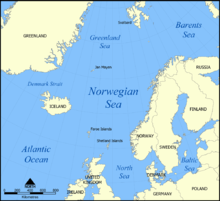Operation Rösselsprung (1942)
This article includes a list of references, related reading, or external links, but its sources remain unclear because it lacks inline citations. (October 2009) |
| Unternehmen Rösselsprung (1942) | |
|---|---|
| Part of Arctic naval operations of World War II | |
 Map of the Norwegian Sea | |
| Type | Naval operation |
| Location | The Norwegian Sea 69°N 02°E / 69°N 2°E |
Unternehmen Rösselsprung (Operation Knight's Move) was a plan by the German Navy (Kriegsmarine) to intercept an Arctic convoy in mid-1942. It was the largest operation of its type mounted by the Kriegsmarine and resulted in the near-destruction of Convoy PQ 17. The success of the operation was indirect none of the ships engaged the convoy, its losses inflicted by U-boat and aircraft attacks. Despite not making contact with the convoy a number of the ships of Unternehmen Rösselsprung were damaged and the heavy cruiser German cruiser Lützow (1940), ran aground in thick fog, needing three months of repairs.
Background
[edit]Rösselsprung is the Knight's move in chess and was a plan to intercept Convoy PQ 17, expected in late June 1942. Two German naval forces were assembled, one at Trondheim, comprised the battleship Tirpitz, the heavy cruiser Admiral Hipper and six destroyers (Admiral Otto Schniewind); the second, at Narvik, was composed of the heavy cruisers Lützow, Admiral Scheer and six destroyers (Vice-Admiral Oskar Kummetz).
Wolfpack Eisteufel (Ice Devil) of six (later eight) U-boats was established in the Norwegian Sea north-east of Jan Mayen island. An advance line of three boats was also established in the Denmark Strait, north-west of Iceland, to give early warning of the convoy's departure. When the convoy was sighted, the two battle groups would move north and concentrate at Altenfjord, where they would re-fuel and await the order to attack to intercept the convoy in the region of Bear Island.
Rösselsprung was handicapped by complex command arrangements, with authority resting with Hitler and contradictory orders, the forces were instructed to attack and destroy the convoy and to avoid any action that would lead to damage to the capital ships, particularly Tirpitz.
Action
[edit]
Convoy PQ 17 left Hvalfjörður in Iceland on 27 June 1942 but it was not detected by the advance patrol. No warning of the convoy was received until 1 July, when it was spotted by U-456 when the convoy was already past the island of Jan Mayen and was closing with the reciprocal Convoy QP 13. The cumbersome command structure hampered Rösselsprung and no move was made until 2 July; Tirpitz, Hipper and four destroyers left Trondheim at 20:00; Lutzow and Scheer with their five destroyers left Narvik at 12:30 on 3 July. The sorties were taken through channels between the Norwegian Islands and the coast, sometimes known as the Western Leads. The Leads are sheltered and hidden but difficult to navigate and the battle groups encountered trouble almost immediately; three of Tirpitz's escorting destroyers ran aground and were forced to return to port. Tirpitz and Hipper with one remaining destroyer arrived at Vestfjord, off Narvik, on 3 July and at Altenfjord at 10:00 on 4 July. Kummetz's battle group also had trouble. Lutzow ran aground in Tjel Sund and was also forced to retire, Kummetz shifted his flag to Scheer which arrived at Altenfjord on 4 July.

The northwards move by Tirpitz and Hipper had been detected by Allied intelligence and the Admiralty took the decision to scatter the convoy, which commenced at 22:15 on 4 July. Over the next six days, twenty ships were lost of the 24 ships sunk. The German naval signals intelligence service (B-Dienst) quickly realized that the convoy was scattering and Schniewind requested permission to sortie. Again, the chain of command was slow to give permission causing a delay until 15:00 on 5 July and then with the caveat to avoid action with the British capital ships. Eisteufel was instructed to leave the attack on the convoy ships to concentrate on finding and attacking the Home Fleet, particularly the carrier HMS Victorious. At 15:00, the flotilla, now consisting of Tirpitz, Hipper and Scheer, with seven destroyers and two torpedo boats, left Altenfjord and headed north-west toward Convoy PQ 17. Almost immediately, they were sighted by the Soviet submarine K-21 (Commander Nikolai Lunin), who sent a sighting report. Lunin attacked and claimed a hit on Tirpitz but this is not certain. An hour later, the fleet was sighted by a British Catalina and again after another two hours by the submarine HMS Unshaken. Both sighting reports were detected by B-Dienst and at 21:30, Erich Raeder, concerned that the fleet was steaming into a trap, ordered its recall just six hours after sailing.
Conclusion
[edit]Despite indirectly causing the Convoy PQ 17 disaster, Rösselsprung was a disappointing performance by the German capital ships. Tirpitz,[why?] Lutzow and the three destroyers spent a considerable time in dock for repairs. The Kriegsmarine unable to mount such an extensive operation again in the Arctic campaign, and it never saw a comparable naval success.
References
[edit]- Kemp, Paul (2000). Convoy!: Drama in Arctic Waters. Cassell. ISBN 1-85409-130-1.
- Schofield, B.B. (1984). The Russian Convoys. Pan Books. ISBN 0-330-28388-X.
Further reading
[edit]- Boog, H.; Rahn, W.; Stumpf, R.; Wegner, B. (2001). The Global War: Widening of the Conflict into a World War and the Shift of the Initiative 1941–1943. Germany in the Second World War. Vol. VI. Translated by Osers, E.; Brownjohn, J.; Crampton, P.; Willmot, L. (Eng. Trans. Oxford University Press, London ed.). Potsdam: Militärgeschichtliches Forschungsamt (Research Institute for Military History). ISBN 0-19-822888-0.
- Rohwer, Jürgen; Hümmelchen, Gerhard (2005) [1972]. Chronology of the War at Sea, 1939–1945: The Naval History of World War Two (3rd rev. ed.). London: Chatham Publishing. ISBN 1-86176-257-7.
- Roskill, S. W. (1956). The Period of Balance. History of the Second World War United Kingdom Military Series: The War at Sea 1939–1945. Vol. II. London: HMSO. OCLC 174453986 – via Hyperwar Foundation.
